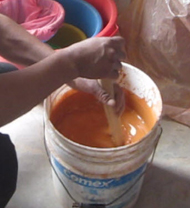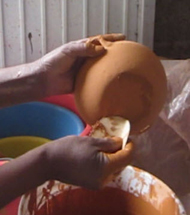Mexican Jarrito, Clay Mug
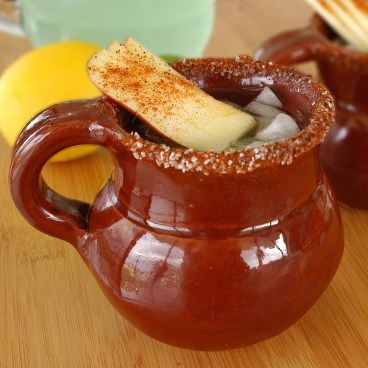
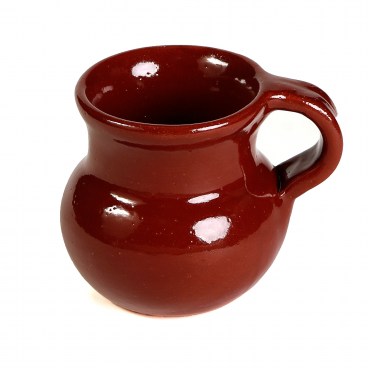
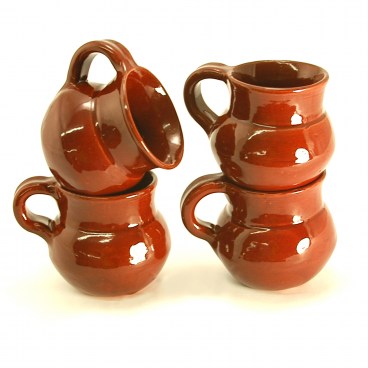
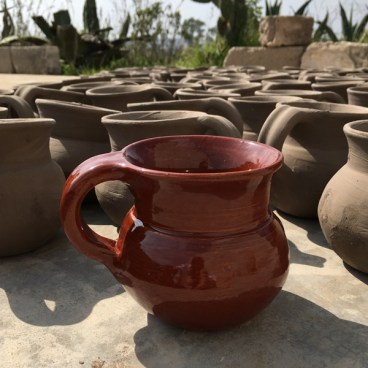
Description
About the piece
Care and Use
Curing
How they are Made
Related Products
Reviews
Wednesday, 09 November 2016
Love my cup! It reminds me of my abuela , it`s a little small but perfect size for coffeeLeslie
Monday, 17 October 2016
I looked for ages to find a flat, sloped-wall pan to substitute for one that had to leave my collection. Paella pans came sort-of-close, then I discovered comal pans. This one has super simplistic design and home-made quality (the edges are a touch sharp, the welded-on handle protrudes below the bottom of the pan, as noted in another review). However, for my gas stove and cast-iron-loving style, it`s fantastic! I treat it like my cast iron, giving it a quick swab of oil and heating on the stovetop after cleaning, and it is nearly nonstick (just remember to make sure it`s quite hot before cracking something like eggs into it, if you want them to come off!)Anonymous
Saturday, 15 October 2016
Two thumbs up. Microwaveable!Marta
Thursday, 22 September 2016
PerfectMark Sanchez
Monday, 12 September 2016
I love it ! In Mexico they really use this tips of cups for hot chocolate it seams to me that has a great flavor in it .Amazon Customer
Tuesday, 19 July 2016
As a child I used these Jarrito to drink oatmeal, coffee and water. So; I`m really happy w this Jarrito, I use it for all my drinks!Jorge Sanchez
Sunday, 31 January 2016
Comal is very nice, good wieght, no rusting, very smooth sirface. The edge of thepan had a burr all the way around that was sharp. My husband has the tools in his workshop to smooth the edge. While working on the sharp edge, he also notice that the ends of the metal bar used for the welded handle extended below the bottom of the pan keeping it from sitting flat. Fortunately, he was able to fix this problem too. So now I am happy with it. Just be prepared for a little tweaking if you purchase this item.Wendy N Stephens
Sunday, 15 March 2015
Love these clay jarritos. I use one of them for my cup of coffee and the other one for drinking water. One thing you need to do is to season these clay mugs; otherwise, they will seep and your drinks will have a funky taste.Cleancutguy




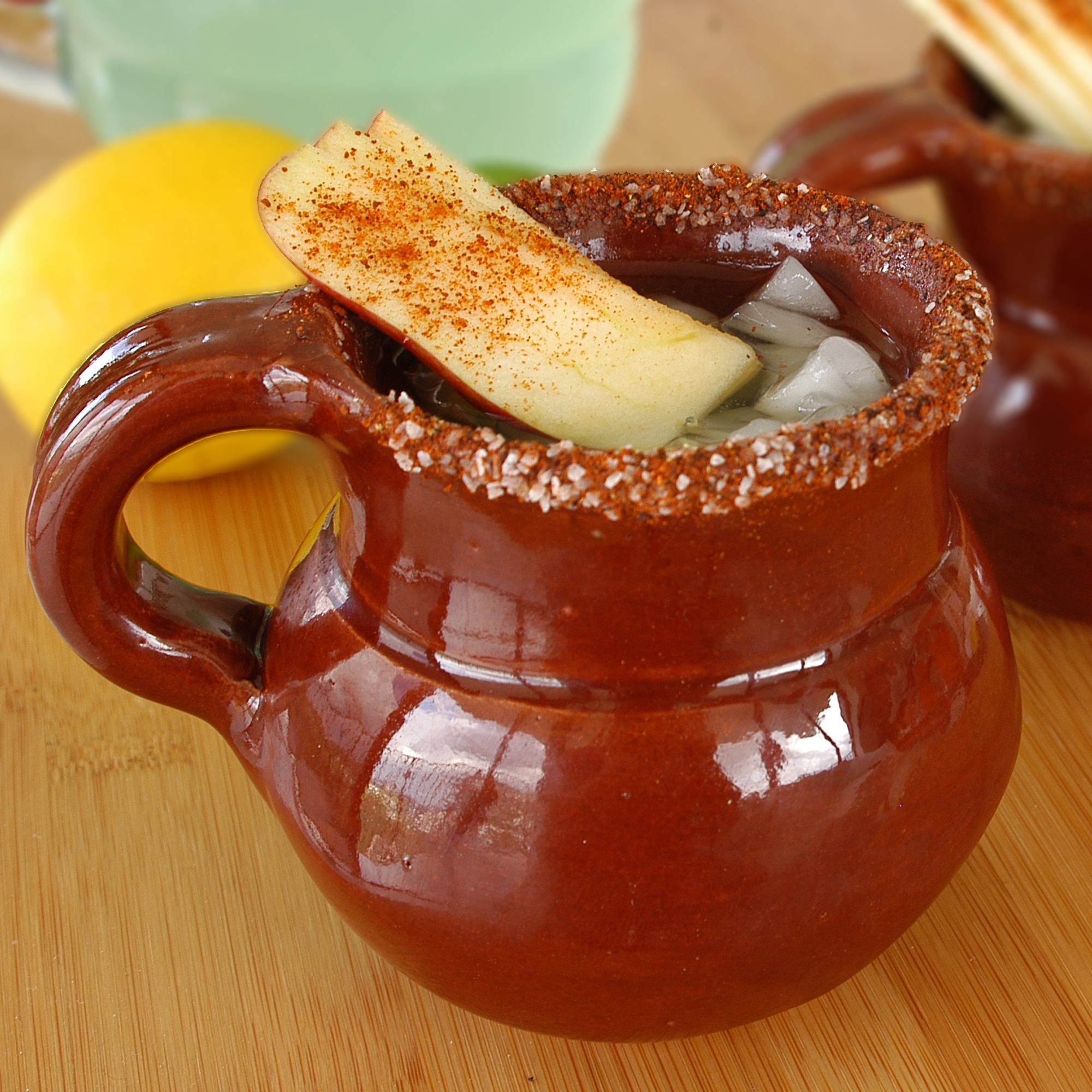


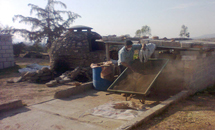 compounds and spread out to dry thoroughly. Once dry, the chunks are ground with the help of an electric grinder, a modern day addition, until they are ground into a fine powder. The powder is then sieved to insure a uniform size, as well as eliminating any possible rocks or pebbles.
compounds and spread out to dry thoroughly. Once dry, the chunks are ground with the help of an electric grinder, a modern day addition, until they are ground into a fine powder. The powder is then sieved to insure a uniform size, as well as eliminating any possible rocks or pebbles.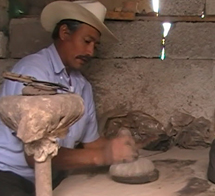 The artisan continues adding water and kneading the mixture, much like a bread maker kneads bread. For the normally large batches this is done on the floor of their workshop.
The artisan continues adding water and kneading the mixture, much like a bread maker kneads bread. For the normally large batches this is done on the floor of their workshop.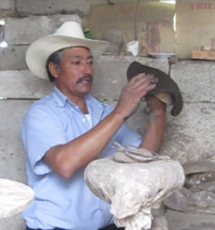 The flattened clay is then molded over molds of the desired shape and size to ensure accurate reproduction of sizes. The piece is then rubbed by hand with water, and further rubbed with a wet lava stone to seal the pores of the clay.
The flattened clay is then molded over molds of the desired shape and size to ensure accurate reproduction of sizes. The piece is then rubbed by hand with water, and further rubbed with a wet lava stone to seal the pores of the clay.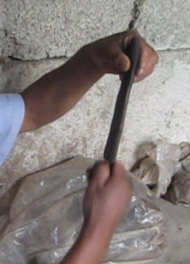 clay forming a rod shaped piece. The rod is then slowly flattened on the work bench using the palms. Dipping the rod in water to make it slippery, the artisan then holds the flattened rod with one hand he uses his other hand to run his thumb downward along the flattened rod to shape the handle the desired contour and making ridges. He then snips off a length to trim the handle to the required length.
clay forming a rod shaped piece. The rod is then slowly flattened on the work bench using the palms. Dipping the rod in water to make it slippery, the artisan then holds the flattened rod with one hand he uses his other hand to run his thumb downward along the flattened rod to shape the handle the desired contour and making ridges. He then snips off a length to trim the handle to the required length.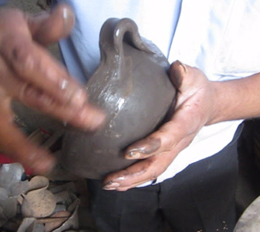 Once the handle is shaped, he attaches the handle to the piece smoothing the joint between the two pieces of clay making the joint invisible.
Once the handle is shaped, he attaches the handle to the piece smoothing the joint between the two pieces of clay making the joint invisible.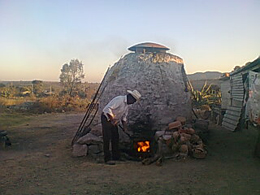 Once fully dry, the now dry and brittle pieces are sanded inside and out with porous lava rocks to ensure a smooth finish, and leaving them ready for the first firing. The first firing is done in a dome shaped wood burning over for over three hours. The pieces are stacked one on top of another in the upper chamber of the oven, while a hard wood fire is lit in the bottom chamber eventually reaching temperatures of over 1,000 degrees Fahrenheit.
Once fully dry, the now dry and brittle pieces are sanded inside and out with porous lava rocks to ensure a smooth finish, and leaving them ready for the first firing. The first firing is done in a dome shaped wood burning over for over three hours. The pieces are stacked one on top of another in the upper chamber of the oven, while a hard wood fire is lit in the bottom chamber eventually reaching temperatures of over 1,000 degrees Fahrenheit.